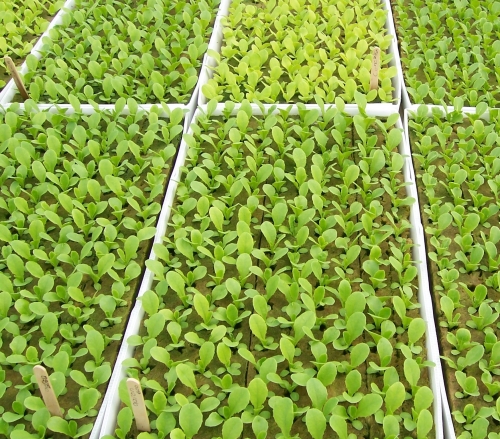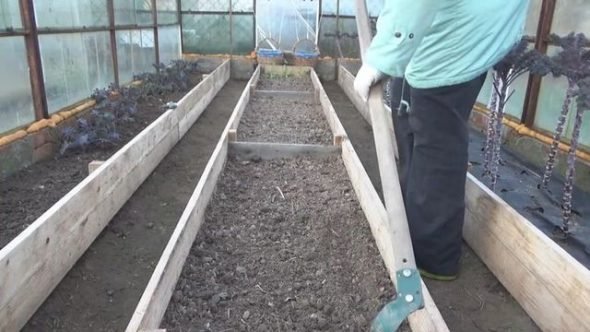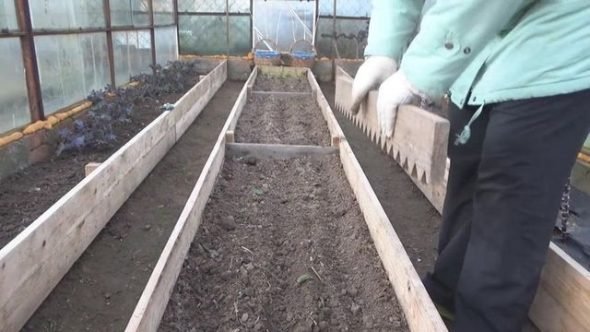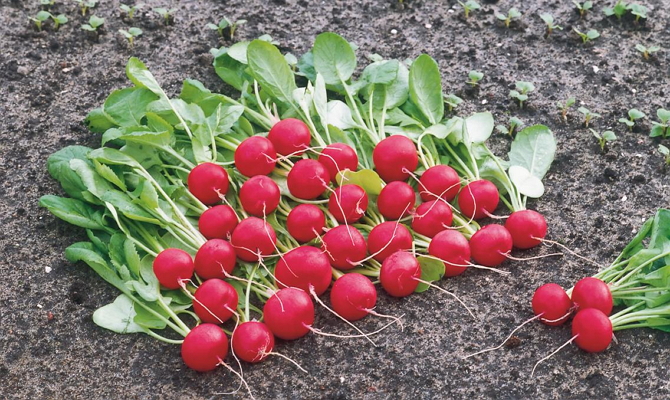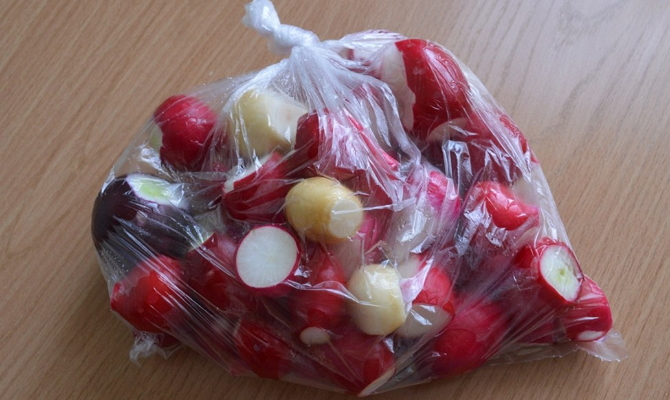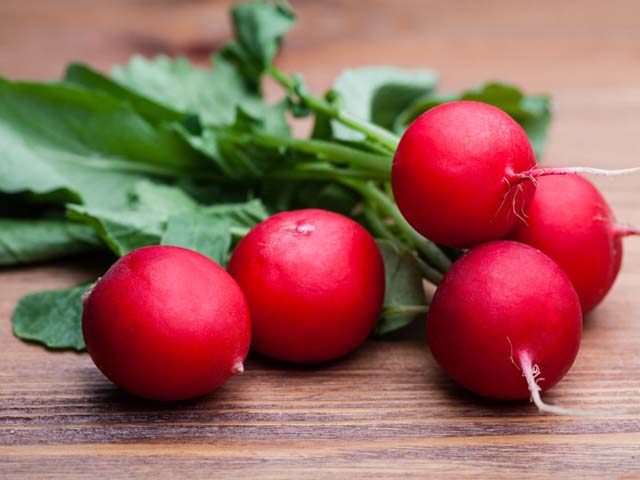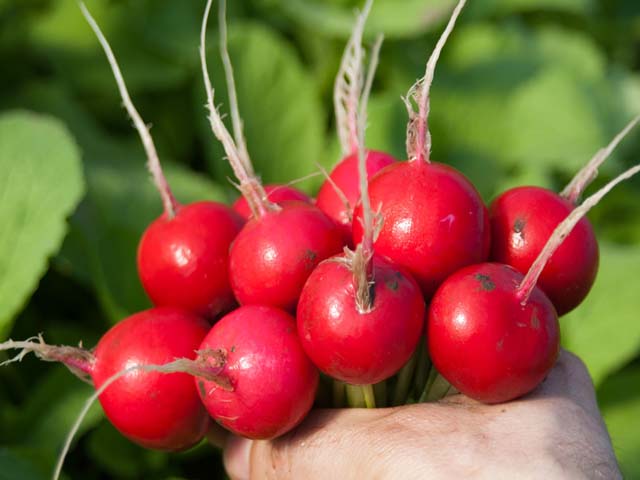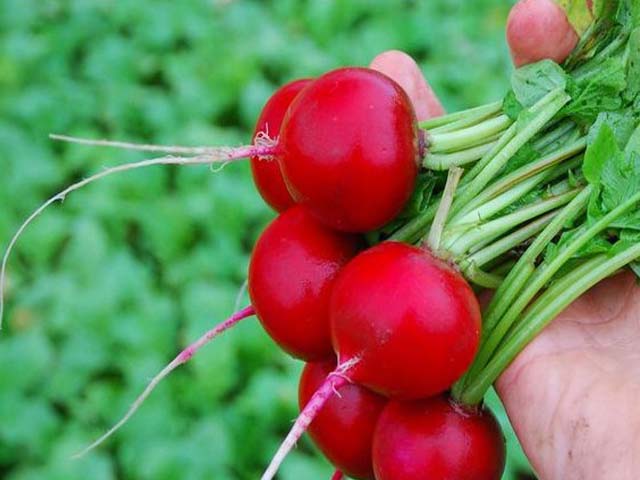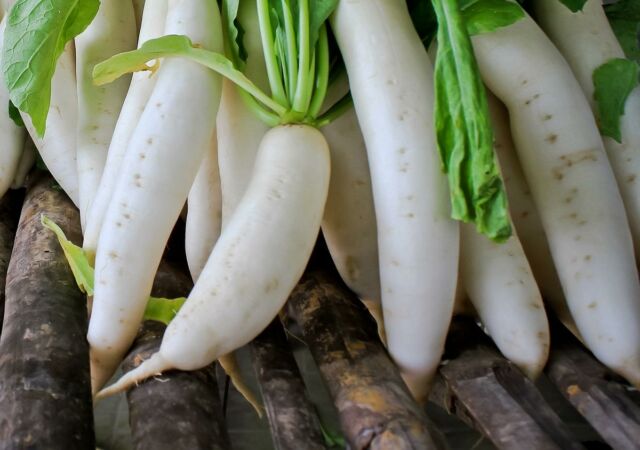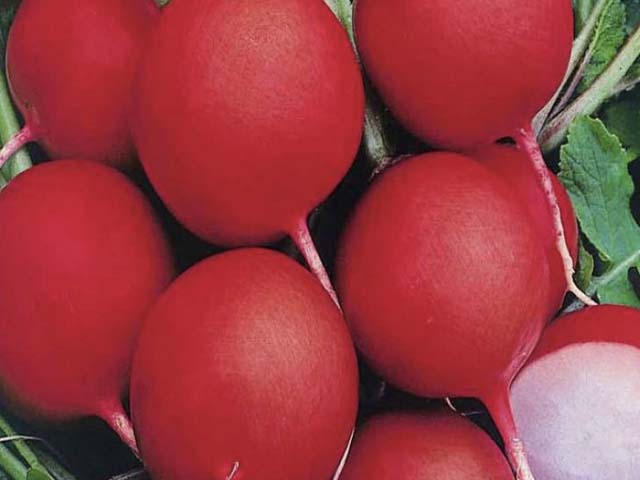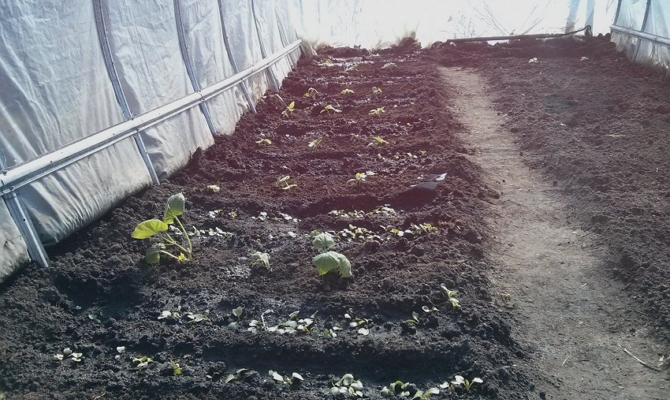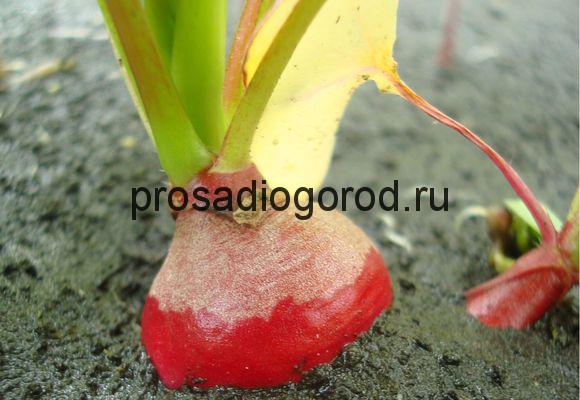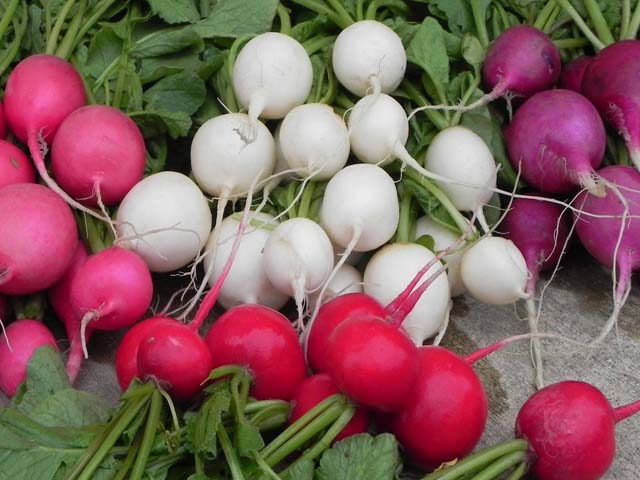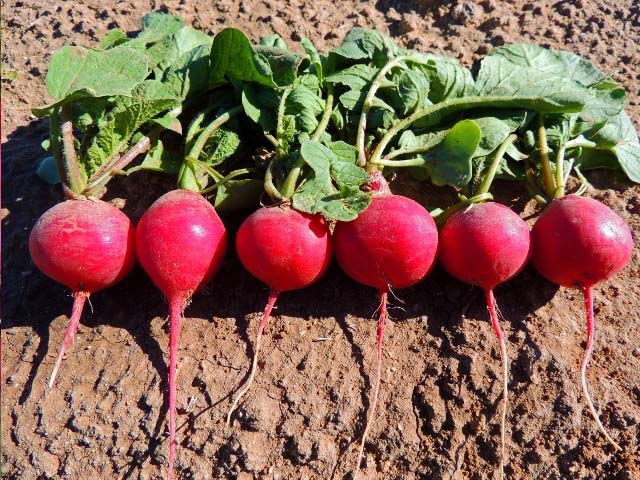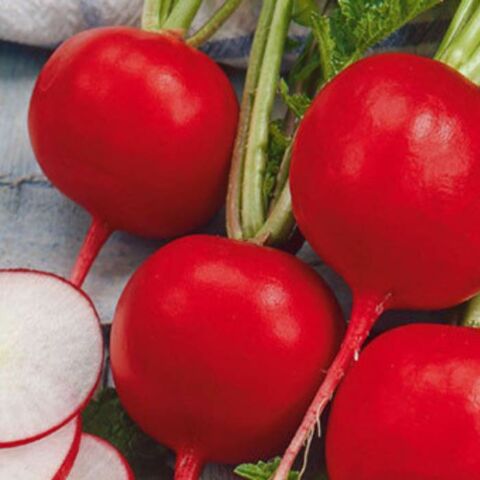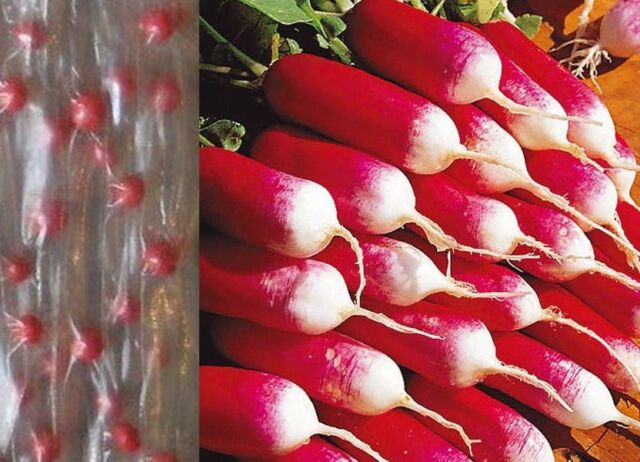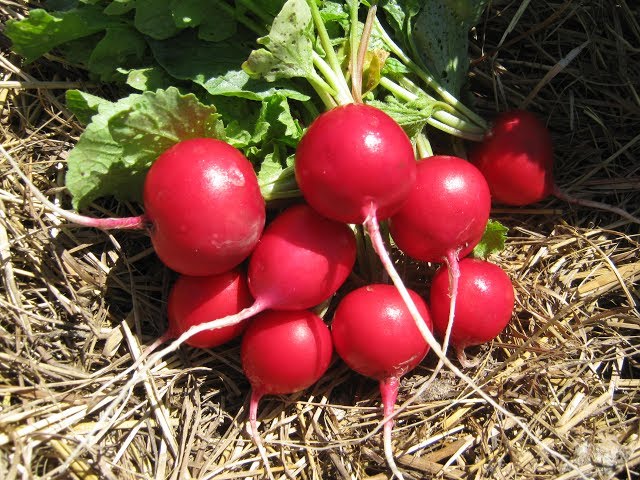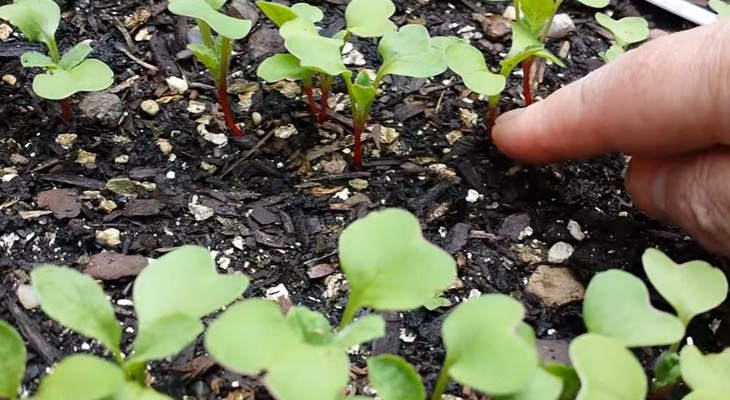Features of vegetable culture
Radish is an annual plant, according to the biological classification, it belongs to the genus Radish, which, in turn, belongs to the Cabbage family. All parts of the plant are edible: roots are used in salads, leaves are used for soups.
Even if you plan to eat only fruits, green tops will also need to be paid attention to while growing radishes in a greenhouse.
Photosynthesis occurs in the leaves of plants (the absorption of carbon dioxide from the environment and its transformation into useful substances necessary for development), so their condition directly affects the formation of the underground part.
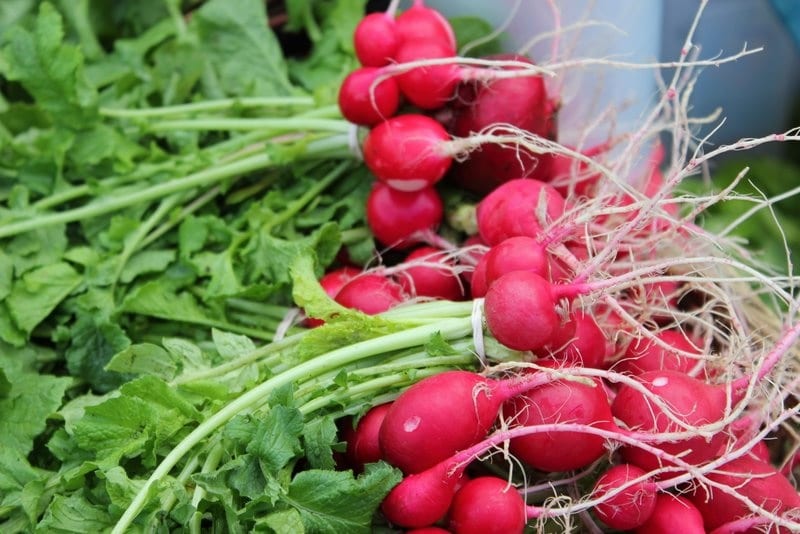
Varieties and growing conditions
Growing various vegetables for sale is an effective business option. At the same time, it is worth knowing how and when to plant radishes in a greenhouse if this root crop is the main product. Such a plant is quite unpretentious and does not require special attention. Timely care, compliance with the basic rules of cultivation and the choice of a suitable variety - these important points will ensure a good harvest and allow you to collect radishes in the winter for sale.
Many varieties of radishes are characterized by fast germination, rich fruiting and good taste characteristics. The effective cultivation of any variety in a greenhouse in spring, autumn or winter for sale is based precisely on these properties of this plant.
At the same time, it is important to choose a variety of radish for the greenhouse, because each type of root crop has certain properties. Also an essential point is the organization and preparation of the greenhouse
All varieties of radish are divided into several types depending on the characteristics. The most early and medium types of crops are suitable for growing in a greenhouse in winter for sale. Varieties that have a maturity of more than 40 days are best planted in the spring. When choosing, it is also worth considering the characteristics of plants and the necessary conditions. The most disease-resistant varieties are Camelot, Mokhovsky, Zarya, Rubin, Heat. In any case, it is necessary to grow radishes at the optimum temperature and in compliance with the rules for the care of root crops. Radishes can be grown effectively throughout the year in greenhouse conditions. The resulting crop may be intended for sale, but in any case, optimal conditions should be created in which the root crop will develop quickly and efficiently. The main points are the following:
All radish seeds are divided into several types that have certain characteristics. For example, hybrid seeds can be planted directly into the ground, as they are treated for diseases and infections. This option is optimal for dry sowing and growing in a greenhouse in winter. A more careful approach and selection require varietal seeds that you can collect yourself. Such elements require a treatment that reduces the risk of radish disease in spring and throughout the growing period in the greenhouse.
Encrusted seeds are plant grains that have a special shell that provides good stimulation of crop growth. Such material can be used for radishes in a greenhouse in winter for sale. The best option are coated seeds, the shell of which is a peat-mineral mixture. This material does not require preliminary preparation and careful processing.
To obtain a rich and high-quality radish crop, it is worth processing simple seeds. The process ensures the disinfection of elements, stimulation of their growth and development.To do this, you can place the seeds in a weak solution of potassium permanganate or use one tablet of immunocytophyte per 100 ml of pure water. Soak the seeds in the solution for about 12 hours. You can also place planting material for a day in a solution of one large spoonful of wood ash in 100 ml of water.
Agrotechnics for growing radishes
General information. Varieties of radish.
In order for this root crop to be regularly on your table, it is necessary to make the correct selection of varieties. In addition, you should sow seeds in several stages, if your summer cottage allows it. Such agricultural technology will allow you to grow more than one good crop during the entire warm season in your country house.
Providing good conditions is not so difficult:
Root seeds Let's highlight a few more:
Beautiful and tasty root crops
.
- Before planting the seeds directly, they can be placed in a damp cloth so that they hatch, and in order to avoid infection of the seedlings with "dry rot", the seeds are heated in 50 degree water for 20 minutes. This will also allow you to get earlier shoots.
- If we talk about temperature, then the radish is quite unpretentious to it.
- Untimely harvesting leads to the fact that the root crop coarsens, and the tops go into the arrow
- I want to see a delicious juicy root crop on the table all summer. This means that you need to plant radishes in several stages, starting in April, under the film, and ending in August. As soon as the first crop has a good leaf, a second batch can be sown on another bed. Some vegetable growers grow radishes at intervals of a week and a half, which ensures uniform ripening of the crop.
Soil preparation before planting
To prepare a working solution, add about 2 cups of fresh ash and about 50 g of laundry soap to a 10-liter bucket of water. Mix everything thoroughly. You can pick up ash on a shovel and crush it over a bed with crops. For some time, insects will limit their harmful activities.
According to its precocity, radishes are divided into several groups:
During the germination of seeds planted in the soil, the temperature should range from 16 to 18 degrees Celsius. Calibration is carried out as follows: Corundum;
When choosing planting material for greenhouses, pay attention to the characteristics of a particular species.
Preparing radish seeds for sowing
Thanks to this growing technology, you can harvest up to 10-15 crops, which is up to 30 kg per square meter. And given that radish is not a cheap vegetable (in the spring its cost is as high as possible), you can not only provide your family with vitamins, but also, if you wish, earn some money to buy seedlings of other vegetable crops.
At the stage of selecting high-quality seed, the seeds can be sifted through a sieve with small diameter holes (up to 3 mm). So you can quickly select high-quality radish grains. At the next stage
plant care
.
For sowing, the soil must be well moistened.
When growing radishes, it is best to use drip irrigation systems, as abundant watering after treatment against pests will wash off the protective composition.
Ultra-early varieties (vegetation period 18 ... 25 days). Very popular among vegetable growers are the varieties "18 days", "Children's F1", "20 days".
Radish pests and their control
When shoots begin to appear, ensure the ventilation of the room by lowering the temperature to 6-8 degrees. (See also the article How to make automatic ventilation of the greenhouse with your own hands)
Take a sieve with a mesh size of two millimeters;
"Togul";
It should be:
We feel the true arrival of spring when the first radish appears on the markets and store shelves.
Seeds are treated with a solution of potassium permanganate and water
up to 3°C. But at temperatures above 25°C, the fruits begin to wilt and become empty inside.The optimal temperature regime for growing radishes is 18–20 ° C.
Harvest and storage
Root crops are freed from tops, rinsed, dried, packed in bags, placed on the bottom shelf of the refrigerator. It is better to choose eco-friendly bags made of kraft paper, which does not prevent the crop from “breathing”. If plastic bags are chosen for storage, holes are made in them or slightly opened. Depending on the type of plant,
Seeds are sown dry
Radishes are harvested as they ripen in the required quantities. As a rule, freshly harvested radishes are immediately eaten. If you water the radishes in the evening and collect them in the morning, do not remove the roots, and cut the tops at a distance of 2-4 cm from the fruit, then it can be successfully stored for up to 7-8 days. Radishes must be placed in a cool room, it is best to store in the refrigerator.
ParnikiTeplicy.com
Autumn planting of radishes in the greenhouse
When you have calmly finished all garden and garden chores, wrapped trees and bushes from rodents, prepared everything for wintering, and the ground began to freeze slightly, it is time for the autumn planting of radishes.
Since seedlings next year will appear in early spring, when the daylight hours are very short, it is better to choose early ripe or medium early varieties that are resistant to low light, such as "Heat", "Dawn", "Rose-red with a white tip".
Harvest with this method of planting is 2-3 weeks earlier than with spring planting, plus the seeds, hardening, undergo natural selection, and only the strongest survive, and as a result, vegetables grow healthy and strong. Also, plantings of radishes planted before winter are very resistant to diseases, frosts and pests, and its sprouts do not suffer from pests. But there are also downsides to this method. There is a risk that during a prolonged thaw, the land in the greenhouse will thaw and plant growth will begin, and subsequent frosts will kill everyone. Therefore, before planting before winter, think about whether it is worth the risk or not. The planting process itself is no different from spring.
1. Wait until nighttime temperatures are below freezing so that the top layer of earth around the greenhouse is shackled.
2. Dig up a bed. Level the ground. Apply fertilizer.
Recommended fertilizer rates:
- 1/2 bucket of compost
- 15gr. potassium salt
- 50gr. superphosphate
3. Make holes 2-3 cm deep in any way convenient for you at a distance of 5 cm from each other.
4. Place 2 root seeds in each hole.
5. Fill all recesses with earth. You can't water! The earth must be dry!
6. When the snow falls, cover all the beds with them, so the seeds will be warmer, and in the spring it will provide the necessary moisture.
On this landing can be considered complete.
Harvesting and storage methods
Radishes in greenhouse conditions ripen a little longer than in open ground. This process usually takes one to two months. The time period largely depends on the variety of radish, temperature and degree of illumination. Harvesting should be done as the characteristic size and color of the root crops is reached. In most cases, vegetables ripen fairly evenly. It is not recommended to delay harvesting, since overripe radish loses its useful and taste properties, becomes dry, hard and hollow.
harvesting ripe vegetables
Knowledgeable people are advised to collect this vegetable at lunchtime after preliminary morning watering. It is believed that in this case, the radish is particularly juicy and high in nutrients. Harvesting is usually carried out in several steps. After extracting the root crops from the ground, for further successful storage, it is necessary to properly process them. First, cut off the tops (it can be used to mulch the soil on the site) and remove the leaves, being careful not to damage the fruit itself.
Then the radish should be thoroughly washed in plenty of cold water, then dried by wiping with a paper towel.After that, we put the root crops in a plastic bag and send them to the refrigerator. The shelf life of radishes grown in greenhouse conditions is 3-4 weeks. However, this is an approximate indicator, which largely depends on the type of vegetable.
We recommend to read
- When to sow green manure in the spring and why: answers to common questions
- Why tomato seedlings do not sprout: reasons for speeding up germination
- Sowing tomatoes for seedlings in February 2019: favorable days and sowing technology
Storing radishes in bags in the refrigerator
Greenhouse radish is also subject to long-term storage. To do this, root crops should be placed in special boxes lined with a layer of polyethylene, and then sprinkled with a sand-peat mixture. This will create a certain alkaline environment that will protect vegetables from decay and the development of characteristic diseases. Good results are obtained by storing radishes directly on wooden shelves. Just remember that then it is recommended to ventilate the basement from time to time, and pour the root crops themselves with wet sand or sawdust. These manipulations are needed in order to disinfect the vegetables, as well as protect them from rotting.
Radish cultivation technology planting, care, processing, harvesting
We will consider the technology of growing radishes under film and in open ground using the example of the Premier variety.
Planting a radish
We start planting seeds in the spring as early as possible as soon as possible. You can sow immediately under the film - in a greenhouse, and in open ground. Radishes are not afraid of cold weather, but they are not in a hurry to grow either. The difference in the development of plants under the film and in the open ground (until the earth and air have warmed up sufficiently) is very large. You can grow radishes from early spring to late autumn.
I sow the seeds immediately with the arrangement. The distance between seeds is 4-5 cm, between rows 15 cm.
The seed germination of the Premier radish variety is about 90-95%, which is very good.
Before planting radish seeds at any time of the year, be sure to spill the grooves with water. The depth of seed placement is no more than 0.5 cm. We sprinkle the seeds in the grooves with loose earth.
The planting of garden plants with small seeds is described in detail in materials about sorrel and leaf lettuce.
Radish seeds under favorable growing conditions (+18, +20 degrees) germinate in 3-5 days. In order to speed up this process, it is necessary to sow soaked seeds. In this case, seedlings appear the very next day.
Planting radish seeds with spacing is the most time-consuming process. You can simplify and speed up the whole thing if you plant seeds on a tape. You can make a tape with seeds in advance yourself. Or buy. For private household plots and for everyone who sows large areas with various small seeds, we can recommend purchasing mini precision seeders.
radish care
Caring for radishes consists of daily watering in dry weather. Radishes love moisture. Yes, he loves it. He doesn't grow without her. Just do not overdo it at the end of the radish ripening. From an excess of moisture, ripe fruits may begin to burst (crack).
Radish is a photophilous plant. But in the spring, you can plant trees in partial shade until their leaves have finally blossomed.
It is undesirable to loosen radishes with a chopper - so as not to damage the root, which is almost on the surface.
If you planted radishes in clean land without weeds, then in 25-30 days, while the radishes are growing, they will not have time to overgrow with weeds.
It is very desirable to grow radishes on fertilized soil. Like all root crops, radishes love loose soil.
From the school biology course, it is known that root crops love potash fertilizers. Radishes are no exception. You can feed something (in moderation) from this series. You can also feed the radish a couple of times with small doses of soluble urea. It is applied when watering at the rate of 10 gr. to a bucket of water.
Harvesting and storing radishes
Everything is simple here. Visually determine which root crop is ripe and carefully pull it out.
Some time before this, a garden bed with radishes must be shed with water so that it gains moisture.
We wash the collected radishes, and ... that's it. The radish is ready to eat.
It is also necessary to cut off the tops and shorten the tip - then the radish can be stored longer.
With uncut tops, radishes will only last a few days. If you put it in a plastic bag and place it in a dark, cool place, the shelf life will increase. For sale, radishes are usually knitted in bunches or unleafed and sold by the kilo.
A little about radish pests
Since radish is a precocious plant, the use of chemicals for pest control is highly undesirable.
The main pest of radishes is the cruciferous flea. Environmental methods of dealing with it are few - tobacco dust or fresh ash. These remedies work, but are not effective enough with a large amount of flea. Especially with daily watering. By the way, wet leaves, the flea does not “leak”, it waits for the leaf to dry. In dry, hot weather, the cruciferous flea is especially rampant.
The main thing is to save the radish shoots from the flea. Later, when the tops of the radish become larger and if there are not too many fleas, then you don’t have to worry - she won’t have time to eat everything.
I read somewhere that young shoots of radish from a flea are covered with spandbond. When I have time, I'll check. You will also need to check garlic infusion on a flea.
In critical cases, to protect against fleas, it is possible to use chemical preparations with a short waiting period for seedlings of early ripe radishes. For example, Inta-Virom (waiting period 20 days). But from the use of Karbofos you need to refrain. For ultra-early radish varieties, chemistry cannot be used.
But this is theoretical. But in practice… I don’t know who treats them with chemistry… I can only guess.
Or maybe you won’t have a flea at all on the site. Sometimes it happens.
It also happened that the bear (kapustyanka) ate root crops. But that was when it was dry all around, she had nothing to eat, and the radish bed was damp. Those. Medvedka eats radishes from hunger.
But who has a blind man wound up in the garden - then not only the radish suffers.
sadimvmeste.ru
Late varieties for greenhouses and planting in open ground
For this group, the typical ripening time is about 40-50 days. Both this and the previous group are optimal for growing in summer or autumn. Their seeds are planted only once during one season - ripening usually occurs in the first days of August.
All of them are distinguished by extremely high yields, resistance to bolting, large root crops with thick skins and a long shelf life (from 2 to 4 months). They range in taste from very spicy, almost like a radish, to almost neutral.
Cherryat F1 is one of the best representatives of this group, refers to hybrids. One of its main features is its high resistance to cold, weather changes and various diseases. The ripening period of root crops is highly dependent on sunlight and averages 40-50 days.
It is better to choose a place for planting with slightly acidic or neutral soil. Gives a high (even for other late species) yield and large bright red round roots. Ideal for transportation and storage - up to 1 month in the refrigerator at a temperature of about 4 degrees.
Zorya is another popular representative in its category. The period from germination to full ripening in open ground is 37-45 days, in protected ground - 38-40 days. The rate of ripening is strongly influenced by sunlight, so it is worth choosing a sunny place for planting with neutral or slightly acidic soil.
It is worth noting the high yield (stably more than 5 kilograms per 1 square meter) and good taste. In addition, it has a long shelf life, can be stored until December when kept in a plastic bag in the refrigerator.All you need is a constant temperature of 4-5 degrees.
Rampoush is another late-ripening representative with an average ripening time of 35-40 days after planting the seeds. The fruits are elongated, with a pleasant medium-sharp taste, without bitterness. It is worth noting the low yield of this variety, and especially large bright red root crops.
Ice icicle - so named by analogy with this winter attribute, has a length of up to 18 cm. Although the variety is not very productive (up to 2 kg per 1 sq. Meter), they like to grow it because of its taste. It is practically not bitter, but it has a pleasant sharpness and juicy taste.
It can be well stored, which is achieved due to the dense skin.
Dungan - has rather large fruits of saturated red color, 5 cm in diameter. Weight ranges from 40 - 80 gr. High-yielding, you can collect up to 3 - 3.5 kg per square meter.
The ripening period is quite long, this may take an average of 50 days, or even more. But the fruits are perfectly stored after harvest in the fall until spring. You need to keep them either in the cellar or in the refrigerator.
The inhabitants of the Urals and Siberia like to plant the red giant in their area. It is resistant to the vagaries of nature, perfectly stored for up to 2-3 months.
The fruits have a sharp, slightly bitter taste. Their size and weight is impressive, individual specimens can grow up to 300 grams. Although the average weight ranges from 80 - 150 grams. which is also not small.
Why is a greenhouse better
If you really like to please yourself with this juicy and crunchy root crop, you can safely grow it all year round. This is within the power of any owner of a greenhouse, since the climate is not an obstacle for this.
If you already have a greenhouse, then radishes can be grown not only for home use, this can become an additional source of income.
greenhouse requirements
The greenhouse must be made of durable and reliable materials. It should be equipped with lighting, heating, ventilation and irrigation systems.
Now polycarbonate greenhouses are quite popular, as they have many advantages, for example:
- All functioning systems are easily mounted;
- It transmits sunlight well and retains heat;
- Does not transmit ultraviolet radiation;
- Equipped with special ventilation vents;
- Has a long service life;
- The flexibility of the material allows you to give any shape, as well as give in to any processing.
For heating greenhouses use different heating systems:
- Stove heating;
- Use of a solid fuel boiler;
- Water heating;
- Heating with solar batteries;
- Gas heating;
- Electric heating.
Radish seeds for greenhouse:
Radishes are grown in greenhouses more often on racks in containers or in cassettes.
How to plant radishes in greenhouse conditions
Growing radishes in a greenhouse in winter is possible from mid-January. This is an approximate indicator, landing dates must be correlated with weather conditions. The minimum temperature level in the greenhouse at night is 0, and during the day the thermometer mark should reach at least 15 degrees Celsius. Immediately before sowing, it is recommended to warm up the ground additionally by covering it with plastic wrap.
Growing radishes in a greenhouse in winter
After a few days, when the upper layers of the soil soften enough, it will be necessary to dig up the soil and saturate it with mineral fertilizers. And after that, you can already proceed directly to the landing process. Radishes should be sown in rows, which should be 8-10 cm apart, to a depth of about 2 cm. At the same time, the distance between the seeds should be at least 2-3 cm. To avoid further thinning, try to arrange the crops in the soil as evenly as possible. After that, cover the area with polyethylene, it will be possible to remove it in a few days, when the seeds acclimatize in the soil.
Sowing seeds of radish in beds
The method of planting radishes in compost heaps is also very popular. This is done extremely simply. First, moisten the compost with hot water, pour a small layer of earth on top and place the prepared seeds there. Protect crops with special shelter. On this landing can be considered over!
Soil preparation before planting seeds
Planting seeds is carried out in a previously properly equipped soil. The soil for planting seeds or growing seedlings should have a neutral environment. In order to properly plant seeds in a polycarbonate structure in the spring, the soil must be prepared in the fall.
The soil in the polycarbonate structure is dug up, it is necessary to apply mineral fertilizers, which include:
- superphosphate;
- potassium chloride.
The soil should not be acidic, as this is fraught with the development of possible diseases of the garden crop. It is recommended to add compost to the dug up soil.
The soil for planting is prepared in the autumn, the distance between your beds should be about a meter. At the same time, care and planting technology are important (it is imperative to regularly water the seedlings, it is also important to treat the beds from possible diseases and pests).
The best varieties for growing in a polycarbonate greenhouse
First, we give the necessary requirements for growing any variety of radish in a greenhouse:
1. Maintaining the temperature not lower than +15 degrees. In the autumn-winter period, the temperature may drop to + 9.
2
As mentioned above, short daylight hours are recommended for him, so attention should be paid to ensuring proper lighting. Otherwise, arrows may appear.
Sufficient lighting - about 1200 lux, but for a short time.
3
Be sure to remember about abundant and regular watering (this is especially important for a hot spring)
4. Regular airing saves from the appearance of black spots on the fruits. You can ventilate after each watering, but taking into account the recommended temperature range.
Necessary crop qualities for successful cultivation in a polycarbonate greenhouse:
Arrow resistance
Arrows easily appear when any of the above points are not observed, which, in fact, are very difficult to constantly maintain. Therefore, initially choose representatives that are resistant to flowering.
Good tolerance to high humidity
If resistance to dry climates was valued outdoors, opposite qualities are required here, which means new special varieties.
- The ability to fully develop in poor lighting.
- Resistance to fungal diseases.
Which of the species have the above properties and at the same time are of high quality of the crop?
Sora is one of the early maturing species with an average growing time of up to 25 days. The fruits have a weight of up to 35 g, in diameter they grow up to a maximum of 5 cm. It is able to produce full-fledged fruits in poor light and relatively high air temperatures, and at the same time it does not shoot.
In addition, Sora also tolerates low temperatures, which allows her to grow in a greenhouse throughout the season (from early spring to autumn). Round, bright red root crops do not form voids during growth and ripen at the same time.
Alex is notable for its ultra-early ripening (16-18 days before mature fruit appears). Like most early varieties, it has a small (up to 20 g) round, bright red root, but has a more pronounced spicy taste. According to its characteristics, it is more suitable for planting in the summer.
It is sensitive to sunlight and stable temperature, but extremely resistant to flowering and lignification of the root. In addition, it has a fairly high yield - up to 3 kg of radish per 1 square meter.This is due, first of all, to the arrow resistance and a small rosette of leaves, which makes it possible to use a close landing (5-7 cm) for it.
Children's is also ultra-early, ripens on the 16th - 18th day after sowing. The weight of the root crop is up to 22 grams, the taste is high - without bitterness and sharpness. Not subject to shooting.
Silesia refers to varieties of medium ripening. After sowing, the harvest can be expected on the 25th - 27th day. Root vegetables are incredibly tender, without any presence of bitterness. They have a cylindrical shape and a beautiful appearance, where the fruit itself is red, and its tip and tail are white.
It does not shoot, it is quite well kept.
Helro is a representative bred specifically for growing in greenhouses. Ripening period 23 - 24 days. Root crops are juicy, without voids, even shape, rich red color.
Saksa is not afraid of frost and can withstand temperatures down to minus 3 degrees. Therefore, it can be sown in the greenhouse very early. Harvest can be obtained after 30 days of growth. The fruits are not too large, up to 20 grams in weight. The tops do not grow very plentiful, so all the power goes to the root.
Taste and presentation are top notch.
Decahas an excellent yield, up to 4 kg per 1 sq. meters. At the same time, the root crops themselves are not too large and have a weight of no more than 13 grams. Juicy to taste, without the presence of bitterness, grows in 22-24 days.
It is no coincidence that the champion received such a name. It has a good yield, up to 4 kg per 1 sq. meters. The fruits are juicy, tender, not bitter. They have an approximate weight of 25 grams, their shape is even, round, with a very bright attractive color. The average ripening period, depending on the conditions, is 25 days.
And so, let's sum up a little. As you can see from the above, you can start planting radishes as early as April, many varieties are not afraid of night frosts, and in a greenhouse, with shelter, you can eat fresh vitamins as early as May.
Many varieties can be planted throughout the spring and summer. Others are planted in the fall and left for storage for the winter. That is, if you competently and competently approach this issue, then no one will definitely be left without a harvest.
What I sincerely wish you. Have a great planting and harvest!
Care
Successful harvesting of radishes in a greenhouse in winter depends on many factors: humidity, temperature, light.
In greenhouse conditions, it is not difficult to set the desired temperature regime at all. To grow radishes, you need to maintain the temperature within + 18 degrees (+ - 2 degrees). But at the first friendly shoots, it is reduced to + 8, or even + 6 degrees, maintaining this temperature regime for about 4 days. So you prevent excessive stretching of seedlings.
If all the radishes have already appeared on the beds, the temperature (both night and day) can be increased by 2 degrees. Those who have been growing radishes in greenhouses for a long time assure that the root crop can withstand up to minus 5 degrees of frost at night.
| On a note. When growing radishes in greenhouse conditions in winter, normal lighting should be in the range of 1300–1500 Lx, which is equivalent to an 8-hour daylight hours. Only in this case, the vegetable will be able to grow technically of high quality and really tasty! |
To protect winter greenhouse radishes from insect pests, they are treated with a mixture of tobacco dust and ash (1/1).
Now everything is simple: thinning - if the seedlings are very thick. The distance between adjacent sprouts is no more than 3 cm. Such a procedure is mandatory, because with strong shading of root crops and tightness, they will not grow large. Another plus of thinning is that thanks to it, the number of root crops that have released arrows is reduced.
In the photo, the process of thinning seedlings of root crops
When cultivating radishes, always remember to water. Produce them every 2 or 3 days, if the roots have already begun to form. After each watering, the soil in the greenhouse should be moistened to a depth of 10 to 15 cm.
| On a note.Watering is really very important for radishes: when the soil dries out, the roots become too hard and bitter. |
Watering should be combined with top dressing. During the growing season, root crops are fertilized with nitrogen fertilizers, but not more than twice (urea is applied - 30 g / m²). If you see obvious signs of a deficiency of some element (for example, magnesium is a sign, yellowing of the foliage), the necessary fertilizer must be applied.
Do not forget that the simplest methods of care in protected ground also need to be carried out: weeding and loosening between rows and rows.
If you have chosen the winter technology for growing radishes correctly, then after 35 (maximum - 45) days you will get a friendly and rich harvest.
| On a note. You can also harvest radishes at home. If you are planting a round variety, take a box about 15-20 cm deep. If you plan to cultivate elongated radish varieties at home, take a 20-25 cm container. But do not forget that radishes are afraid of coolness and dampness when growing. |
